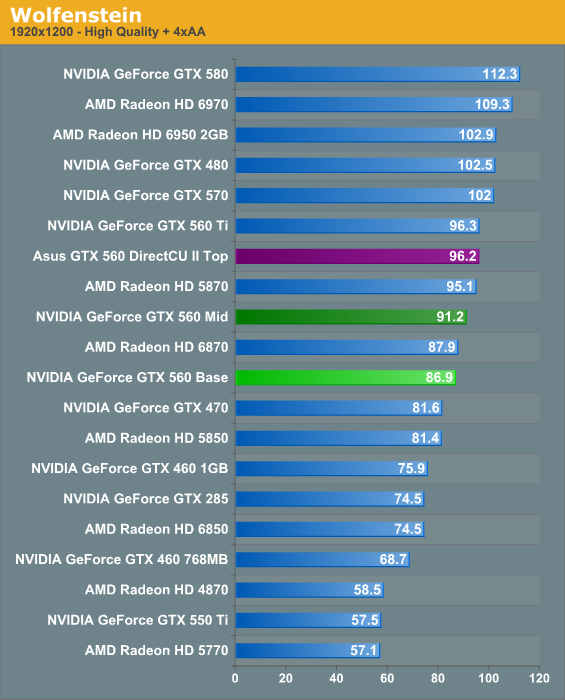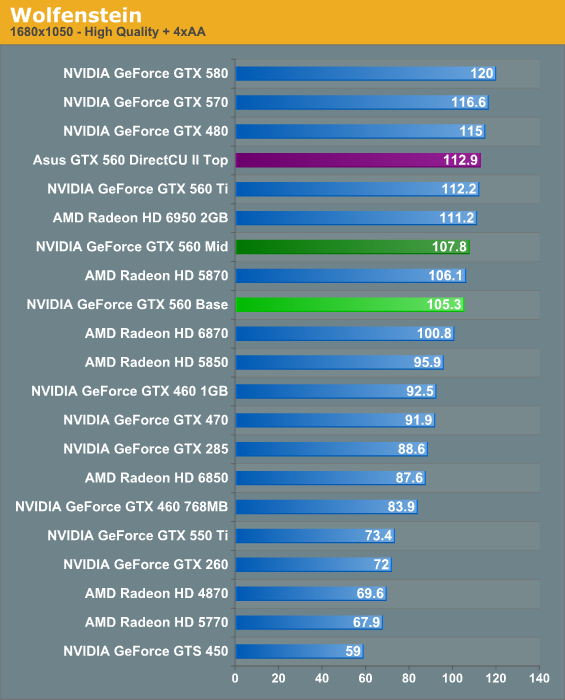NVIDIA's GeForce GTX 560: The Top To Bottom Factory Overclock
by Ryan Smith on May 17, 2011 9:00 AM ESTWolfenstein
Finally among our benchmark suite we have Wolfenstein, the most recent game to be released using the id Software Tech 4 engine. All things considered it’s not a very graphically intensive game, but at this point it’s the most recent OpenGL title available. It’s more than likely the entire OpenGL landscape will be thrown upside-down once id releases Rage later this year.


Our final game once again puts AMD and NVIDIA fairly close, at least around the $200 range. The GTX 560 Mid once again has the lead over the 6870, beating the 6870 out by about 3%. On the flip side the 6950 is several percent ahead of all of our GTX 560 configurations. On a relative basis NVIDIA’s cards end our gaming suite at about the same place they started: the GTX 560 Mid has 20% on the GTX 460 1GB, while the Mid trails the GTX 560 Ti by about 6%. The ASUS GTX 560 DirectCU II Top also closes out at a familiar position, being virtual tied with the GTX 560 Ti.










66 Comments
View All Comments
Grooveriding - Tuesday, May 17, 2011 - link
Would be nice to see a comparison of the 560 to the 460 both at the same clockspeeds.Looking at this review, they will perform exactly the same at the same clocks. But it would be nice to see the comparison none the less.
xxtypersxx - Tuesday, May 17, 2011 - link
I agree, it seems to be a pretty standard refresh except whereas 460's tend to top out around 850mhz, these make it much closer to 1ghz.I hope the all of the manufacturers learned their lesson from the rash of dying 460's a few months after launch and included heatsinks on the VRM's like Asus did. These GF114/GF104 cards draw too much current when overclocked for the manufacturer's to leave the mosfets naked as they did with most launch 460's.
I also liked how the clock scaling was presented in the review, this is a good way to handle the non-standardized speeds. I'm sure you'll get the standard comment whiners screaming bias, but at this point I'm convinced they will do this whenever you show an Nvidia card even power on correctly.
L. - Thursday, May 19, 2011 - link
I'm pretty sure they didn't learn too much, seeing what happened to tdp-control on the 590 ... (i.e. nerf the card else it's gonna blow up) - quite normal though, trying to put two 350 watt gpu's on the same board was a retarded idea, since it's not supposed to be a hairdryer.iGas - Sunday, July 10, 2011 - link
I agree.Would be nice to see a direct comparison clock for clock. And, perhaps a comparison with the 470, and 480 at base clock and OC.
PS. My MSI GTX 460, humming along perfectly at 940mhz (and it did broke into 1011mhz territory).
DarknRahl - Tuesday, May 17, 2011 - link
Larger resolutions would be handy.Stuka87 - Tuesday, May 17, 2011 - link
It would be interesting to see them tested on a 27" display, but most single card setups fall on their face at that resolution (2560 x 1440).L. - Thursday, May 19, 2011 - link
Well that's where you see AMD cards (2GB) get some more points.But as discussed .. makes more sense to have 2* 1080p instead, financially.
michaelheath - Tuesday, May 17, 2011 - link
Why? Nvidia pretty much said last week that the target market for the GTX560 was users who want an affordable card to play games at 1080p resolution. Who would buy a $200 graphics card to play on a $1000+ 2560 x 1440/1600 display anyway? If you have that much money in your pockets for a high-quality display, why would you skimp out on the graphics card?Ushio01 - Tuesday, May 17, 2011 - link
http://www.overclockers.co.uk/showproduct.php?prod...Only £440 ($660).
L. - Wednesday, May 18, 2011 - link
It is clearly dumb to think resolutions will stay at the same level for eleventy beelion years.Anyone who has a good monitor wants to make use of it and might want to know how it's going to work.
Besides, your 1000 bucks figure is like 3x the price for some of the cheapest 2560* .
And, 200 bucks is not exactly "skimping out" on the gfx ...